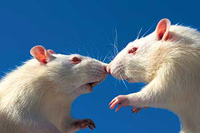Lab mice industry celebrates 100th anniversary
The world marks the 100th anniversary of lab mice in 2009. The century-long anniversary is not quite correct. Researchers – physiologists and microbiologists - began to use mice for lab tests in the 19th century. For example, Robert Koch used mice during the 1870s to discover anthrax bacteria. Paul Ehrlich conducted hundreds of tests in the beginning of the 20th century in an attempt to transplant a tumor from one mouse to another one.

Scientific experiments require two absolutely identical lab objects. One of them is the direct objects of tests, whereas the other one is used to conduct control tests. Living organisms – either plants or animals – must be genetically identical to be useful in lab tests. Scientists have to resort to the method of inbreeding or consanguinous mating for several generations to receive genetically identical animals.
The first generation of genetically identical mice appeared in 1909 owing to the efforts of Clarence Cook Little of Harvard.
Mice are unpretentious, it is very easy to feed them, they breed fast and they are small in size. Mice can be a very good model for human biological processes. Apes or pigs are a lot closer to humans, but it is very hard to keep them. That is why millions of mice inhabit countless laboratories all over the world.
Clarence Little founded the Jackson Laboratory in 1929 in Bar Harbor, Maine. The Laboratory's mission is to discover the genetic basis for preventing, treating and curing human diseases, and to enable research and education for the global biomedical community. The Laboratory is also the world's source for more than 4,000 strains of genetically defined mice, is home of the mouse genome database and is an international hub for scientific courses, conferences, training and education.
Dr. George Snell, a scientist with the Jackson Laboratory, discovered the major histocompatibility complex genes, a discovery that lead to higher success rates of organ transplants. The discovery earned him a Nobel Prize in 1980.
Mice are widely used in the study of cancerous and immune diseases, as well as in transplantology and many other fields of modern medicine. Psychologists and psychophysiologists use lab mice to study mechanisms of memory and orientation.
Scientists made a lot of landmark discoveries with the help of mice. For example, Martin Evans used lab mice to culture embryonic stem cells in 1981.
Various strains of laboratory mice have been created for scientific purposes in the world. The most recognizable one of them is known as BALB/c (Bagg albino C) - it is an albino strain created by Halsey J. Bagg of Memorial Hospital , New York. The mice of this strain are used in immunology and oncology.
The modern-day lab mice industry offers a wide range of related products: special fodder, running wheels, mazes, X-ray devices, tomographs, etc.
A number of monuments to lab mice have been erected in the world. In Russia, such a monument can be found near a veterinary laboratory in the town of Zadonsk, the Lipetsk region.
Subscribe to Pravda.Ru Telegram channel, Facebook, RSS!





